450 Years of CVX CLC – Homily of Fr. General at St. Ignatius’ Church, Rome
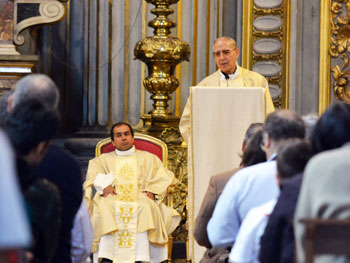
0n 28 April 2013, at the church of St. Ignatius, Fr. General celebrated Eucharistic with the pilgrims of the Ignatian Lay Communities from various parts of Europe. This was the occasion of the 4th Stage of the European pilgrimage marking the 450th Jubilee Year of Grace of World CLC from March 25th 2013 to March 25th 2014.
|
|
| Download MP3 |
Wisdom Story 59

by Paul Brian Campbell,SJ
A poor farmer was returning from the market on his cart driven by oxen. It was getting late, and he was passing through a forest when suddenly one of his wheels came off. After an hour trying to fix it, he realized that he would not be getting home in time for his evening prayer. He spread a rough blanket on the ground and looked for his prayer book in his bag.
“Oh no! It’s not there. Where did I put it?” His anxiety quickly reached panic proportions as he his frantically searched his ox cart. “I must have left it at home. Oh God, what am I to do? You know very well that my poor brain has never been able to commit a single line of prayer to memory.”
He fell to his knees, wringing his hands. “Oh Lord, I am so sorry. I have made a terrible blunder today. I did not foresee that I could have been delayed so long. In the future, I will always take my prayer book with me.”
He paused and took a deep breath. “OK, this is what I will do, my Lord. I will say five times, and very slowly, the letters of the alphabet. You know all the prayers. Please arrange the letters together in a way that pleases You.”
God told his angels, “This prayer I like, because it is coming from a simple heart.”
Jesuit Superior General Appointed Head of International Organization of Religious Orders

Jesuit Father General Adolfo Nicolás, superior general of the Society of Jesus, has been appointed president of the International Union of Superiors General (UISG), which represents the superior generals of more than 200 male religious orders. Fr. Nicolás will serve a three-year term and succeeds Franciscan Father José Rodriguez Carballo.
Founded by the Congregation for Religious, UISG’s purpose is to promote the life and mission of individual institutes that work in service of the church in order to make their collaboration more efficient and contact with the Holy See and the hierarchy more fruitful.
All superiors general of religious institutes or societies are members of the UISG. As superior general of the Jesuits, Fr. Nicolás is the leader of the largest religious order in the world. His long experience in Asia and his ability to govern are qualities the Society of Jesus sought in January 2008 when Fr. Nicolás was appointed superior general.
Fr. Nicolás was born in Palencia, Spain, in 1936. He has a degree from the Pontifical Gregorian University, and he completed a Master of Sacred Theology in 1971 at Sophia University in Tokyo, where he went on to become a professor of Systematic Theology. He was director of the Pastoral Institute in Manila from 1978 to 1984, and from 1991 to 1993 he was rector of theologate in Tokyo. He served as provincial of the Jesuit Province of Tokyo between 1993 and 1999. From 2004 to 2007, he was president of the Jesuit Conference of Provincials for Eastern Asia and Oceania.
Wisdom Story 58

by Paul Brian Campbell,SJ
Perfect peace? I asked for perfect peace and what do I get? A picture of a storm!? Nonsense. What was the artist thinking of…” The king felt a storm of anger rising within his belly the effrontery of one of his subjects to disobey him so openly. To cool his temper, he looked at the next painting.
“Now this painting here, that’s what I call peaceful. A calm lake, some beautiful mountains reflected in it. Oh and that magnificent sky, with just a touch of puffy little clouds. What artistry, what serenity, what…”
The king moved on to the next painting in his huge exhibition gallery. All the best artists of his kingdom and abroad had entered his competition to depict “perfect peace” and win the coveted position of Royal Court Painter.
Gazing at a serene pastoral painting, the king found himself thinking again “This is indeed a peaceful scene, but somehow it doesn’t help me feel peaceful.” His mind returned to pondering the picture of the storm. Had he missed something, or was the artist a practical joker? He walked back to that first painting to have another look.
Lightning flashed on the bare crags of the mountains, knifing into a dark and furious sky. Foaming waters gashed the dark gullies as they thundered into the flooding river. The king found his gaze following the line of the largest torrent from its source downwards.
He peered closely at the painting.
A smile spread across his face.
There, in the heart of the raging waters, growing from a cracked rock was a delicate shrub shielding a nest. Unaffected by the violent surroundings was a small bird sitting calmly in its nest.
The king knew he had a winner.
The Land of the Gerasenes
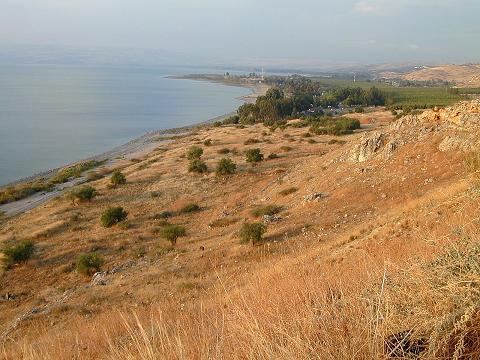
by James Martin, S.J.
Whenever I find myself in a confusing pastoral situation, I ask myself a question that has, sadly, become something of a punch line: “What would Jesus do?”
Yes, I know the phrase has been almost drained of meaning thanks to overuse, but it still has great value for those who minister in Jesus’ name. And once I ask that question, an answer usually presents itself. Be kind. Be merciful. Be forgiving. Listen carefully. Above all, love.
But lately I’ve been wondering if that question can cover all the bases in ministry-or in life. Specifically, I’ve been wondering: What is the best way to deal with emotionally unstable people?
Everyone in ministry will run into this challenge at some point. How do you minister to people who are not simply bothersome, not simply annoying, but seriously unstable? How, in a church setting, can you treat them both compassionately and wisely? In the past few weeks, I’ve been talking with members of the clergy and with lay ministers looking for answers.
Even though I don’t work in a parish full time, I face this challenge regularly. Recently (I’m changing some details) a person who had been posting on my public Facebook page requested my e-mail address so that he could ask me for some personal advice. Now what’s a priest to do? I don’t want to be uncharitable or shirk my priestly duties, so I agreed. Soon I was deluged with e-mails describing his problems in detail. Each time, I tried to respond as well as I could. His e-mails soon became angry-mainly about the world in general. When I didn’t respond within a few hours, they got even angrier. Finally, a few weeks ago, I received one that used the “F-word” several times. I had to ask him not to contact me any more. Then I received on Facebook, Twitter and by e-mail more “F-bombs” from the same person.
Years ago, in a parish book club that met monthly, I was frustrated when one of our meetings was hijacked by someone who was not simply rude or obstreperous, but clearly mentally disturbed. I struggled between wanting to be charitable and also trying to maintain a space for the other parishioners, who were looking forward to the evening. Finally I asked the person to let others speak. She glowered at me throughout the meeting, and then on her way out used the “F-word.”
Lately I’ve been thinking, “What would Jesus do?” I had to smile at the answer. He would heal them! The story that came to mind is the account of the Gerasene demoniac (Mk 5:1-20). Jesus and the disciples have just crossed the Sea of Galilee in their boat and a notorious “demoniac” (a man possessed by an “unclean” spirit) accosts Jesus. He screams, “What do you have to do with me, Jesus, Son of the Most High God?” After a brief back-and-forth, Jesus heals the man, and he is later found to be “in his right mind.” Many times I wish I could do that.
Conversations with Catholic pastoral ministers have proved illuminating. Some said they strive to be as kind as they can until the person becomes disruptive or violent. Then they must set limits. Others told me that sometimes people just need a little attention and loving care, and simply listening to them-as Jesus did-may defuse the situation.
I don’t know the answer to this serious pastoral question. I think that it begins with charity, but it should also include prudence and a concern for others in the parish or in the ministerial setting-including oneself.
People who are unstable but not violent are easier to minister to. Of course, even these people may present a challenge, particularly since, in my experience, they tend to return over and over. Some people I spoke with shared with me a few examples of a more jocular approach. One priest said that when an unstable woman said to him, accusingly, after Mass, “Jesus told me in prayer that you’re not holding the host high enough at the elevation,” my friend said, “What time did he say that?” “At 9 this morning,” she replied. “Well,” said my friend calmly, “That’s okay. At 9:30 Jesus told me I was holding it at just the right height.”
My favorite response came from a priest who was accosted by a wild-eyed man who said that he had a message from the devil to give him.
“Oh,” he said gently, “messages from the devil are handled at the parish down the street. Would you like their address?”
James Martin, S.J., is editor at large of America and author of the new e-book Together on Retreat: Meeting Jesus in Prayer.
Tax prep as Ignatian practice
by Richard A. Kauffman

When I was doing my taxes this year, it occurred to me that the process is a bit like praying the prayer of examen. This Ignatian prayer is used at the end of the day to think back on what happened that day, to ponder where God was in it and to think ahead to the next day. In doing my taxes, I was forced to think back on the events of my life in 2011, both the good and the bad.
While the daily examen leads to prayer, a financial review of a whole year can lead to cursing. But going over my finances for 2011 brought pleasant memories along with the unpleasant and bittersweet ones. I felt gratitude for the good fortune of discovering a doctor who was able to do a delicate but minimally invasive surgical procedure on me. He spared me having to go through major surgery with a prolonged and painful recovery period.
I thought too of the deterioration of my mother’s health last year, including the loss of some of her memory and even an unexpected shift in her personality. While she might not yet be ready to claim death as her friend, I was reminded of this notion of Henri Nouwen’s: I hope that she can make peace with death before it comes, to even welcome it as friend.
Many of my pleasant thoughts involved travels. The year was unusual in that it took me on separate trips to three coasts. The expansive and relentless motion of oceans and the shifting of sand cause me to go inward and to think deeply about life. I reflect on the times past and anticipate the time when I’ll no longer be present to this world.
Family get-togethers also surfaced in my memory. Why do some of the best and worst of times involve our families–the ones we come from as well as the ones we bring into this world?
Using the examen prayer as a template for thinking about taxes gave me a different perspective on that dreaded task and deadline. I had to think about where God was in my life last year–or, better still, where I was in relation to God. As with the examen prayer, I thought too about the rest of this year. I wondered what experiences will enter my reflections next year.
May 24th 1542 – Our Lady of the Way
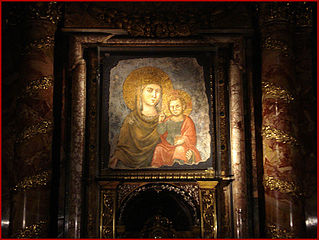
When Ignatius, Faber, and Laínez came in 1537 to Rome, Ignatius had discovered in the centre of the city, in the vicinity of the Capitol, a small church of Our Lady with the holy image ‘Madonna della Strada’. Time and again he instructed the Fathers to say Mass there. He longingly hoped for an opportunity to acquire that church. It was not so beautiful, but ideally situated as starting point for pastoral activities in the city.
This opportunity resulted from Father Codacio who had got that premises in hereditary tenancy on August 19th 1540, and had attained on November 18th the benefice of the parish St Maria della Strada. With the family Camillo Astalli who owned that complex Codacio worked for the transfer of the church with the holy image to the young Order. On May 15th 1542 Ignatius was inaugurated solemnly in the possessions of the sanctuary, whereas the parish pastoral was shifted to St Marco. It was the first church in the possession of Jesuits.
At the beginning of February 1541 the First Fathers had moved from the Piazza Frangipani into an old, narrow house. It stood opposite the small church and was rented for thirty Scuds annually. By demolition and new building the Professed House and the Church Il Gesù arose from those beginnings. Only under Francisco de Borja, the third General of the Order, was laid the foundation-stone for the building of Il Gesù on June 20th 1568. Architect was Jacopo Vignola, the successor of Michelangelo. The building dragged on for sixteen years until 1584.
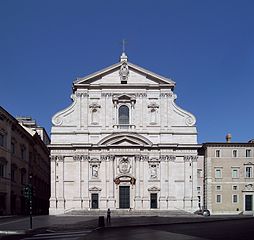
In this church is in front on the left side the Grave Altar of St Ignatius of Loyola. On its right is venerated the holy image ‘Madonna della Strada’. In the Professed House of the Jesuits just beside Il Gesù the three rooms once inhabited by Ignatius are still shown in their original form. Only the walls are covered with silk wallpapers.
To the building of Il Gesù contributed many donors. The chief patron was Cardinal Alessandro Farnese (who died at the beginning of March 1589). Farnese was Vice-Chancellor and led the state affairs since 1538. For full fifty-five years he belonged to the College of Cardinals. He took part in seven conclaves, often in the role of the ‘pope maker’. He was the ‘Grand Cardinal’, who was unmatched in experience and insight, generosity and charitableness for the poor. Uncommonly rich, he was devoted to the arts, the sciences, and the humanists. To the recent Society of Jesus Farnese was a generous promoter and an influential advisor. The Order owes him its main church Il Gesù, and the Roman Professed House.
Pope Francis: Call to prayer for the Church in China
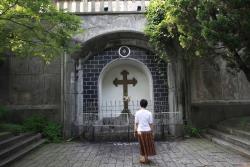
(Vatican Radio) Pope Francis has called Christians worldwide to prayer this Friday for our brothers and sisters in China. Speaking at the end of his general audience in Italian, the Holy Father noted that Friday, May 24th, is the day dedicated to the liturgical memory of the Blessed Virgin Mary, Help of Christians, who is venerated with great devotion at the Shrine of Sheshan in Shanghai.
He said : “I urge all Catholics around the world to join in prayer with our brothers and sisters who are in China, to implore from God the grace to proclaim with humility and joy Christ, who died and rose again; to be faithful to His Church and the Successor of Peter and to live everyday life in service to their country and their fellow citizens in a way that is consistent with the faith they profess.
Making our own a few words of prayer to Our Lady of Sheshan, together with you I would like to invoke Mary : ” Our Lady of Sheshan, sustain all those in China, who, amid their daily trials, continue to believe, to hope, to love. May they never be afraid to speak of Jesus to the world, and of the world to Jesus”.
Mary, Virgin most faithful, support Chinese Catholics, render their commitments, which are not easy, more and more precious in the eyes of the Lord, and nurture the affection and the participation of the Church in China in the journey of the Universal Church”.
In May 2008 Pope-emeritus, Benedict XVI, composed a special prayer for the Feast of Our Lady Help of Christians (May 24), venerated at the shrine of Sheshan, near Shanghai. He also designated May 24 as the yearly World Day of Prayer for China and asked that we recite this prayer.
Below we publish the full text of the prayer to Our Lady of Sheshan
Virgin Most Holy, Mother of the Incarnate Word and our Mother,
venerated in the Shrine of Sheshan under the title “Help of Christians”,
the entire Church in China looks to you with devout affection.
We come before you today to implore your protection.
Look upon the People of God and, with a mother’s care, guide them
along the paths of truth and love, so that they may always be
a leaven of harmonious coexistence among all citizens.
When you obediently said “yes” in the house of Nazareth,
you allowed God’s eternal Son to take flesh in your virginal womb
and thus to begin in history the work of our redemption.
You willingly and generously cooperated in that work,
allowing the sword of pain to pierce your soul,
until the supreme hour of the Cross, when you kept watch on Calvary,
standing beside your Son, who died that we might live.
From that moment, you became, in a new way,
the Mother of all those who receive your Son Jesus in faith
and choose to follow in his footsteps by taking up his Cross.
Mother of hope, in the darkness of Holy Saturday you journeyed
with unfailing trust towards the dawn of Easter.
Grant that your children may discern at all times,
even those that are darkest, the signs of God’s loving presence.
Our Lady of Sheshan, sustain all those in China,
who, amid their daily trials, continue to believe, to hope, to love.
May they never be afraid to speak of Jesus to the world,
and of the world to Jesus.
In the statue overlooking the Shrine you lift your Son on high,
offering him to the world with open arms in a gesture of love.
Help Catholics always to be credible witnesses to this love,
ever clinging to the rock of Peter on which the Church is built.
Mother of China and all Asia, pray for us, now and for ever. Amen!
The Role of Crafts in Catechesis
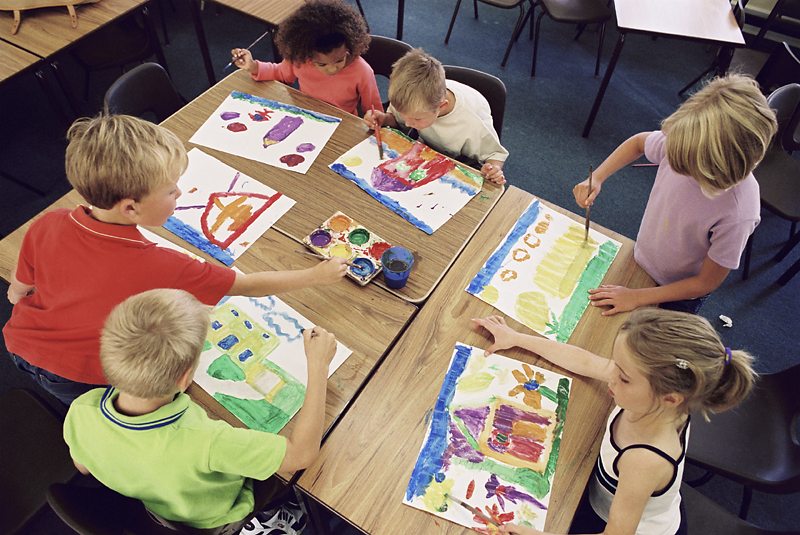
by Joe Paprocki
Did you know that the Bible begins with a craft activity?
The Creation stories in the Book of Genesis (chapters 1 and 2) explain to us how, out of the divine imagination, God crafted the heavens and the earth, the stars, the sun, the moon, the oceans, plants, and living creatures, culminating in the crafting of human beings.
Simply put, crafting is the art of creating an object with skill and careful attention to detail. Creation is nothing other than God’s craft-work. Made in the image and likeness of God, we human beings are driven to create. Crafting is a way of participating in the creative nature of God and in the Divine imagination.
Crafting has a long privileged place in catechesis. The making of crafts allows people of all ages to concretely and creatively express their understanding of the faith and their relationship with God and the Church. Art is a language that we use in catechesis to “bring the divine to the human world, to the level of the senses, then, from the spiritual insight gained from the senses and the stirring of the emotions, to raise the human world to God, to his inexpressible kingdom of mystery, beauty, and life.” (NDC 37B1).
Crafting also is an effective teaching method for those whose learning style is not primarily word-based. People who are more comfortable drawing than writing deserve opportunities to express themselves through art. Likewise, some people simply learn best when they are invited to do something.
Crafting allows those learners who are more visual, artistic, and physical to express themselves and to learn in a manner that more closely fits their learning style. Even for those whose learning style is more word-based, crafting offers an opportunity for a change of pace. Learning in general is more effective when a variety of methods are employed and when participants are actively engaged.
Finally, the Catholic faith is fundamentally sacramental-it is a faith that goes beyond words and recognizes God’s presence reflected in the things of our world. The Catholic imagination looks to the elements of creation as channels of God’s grace. Whether it be the “official” sacramental elements such as water, bread, wine, oil, and fire, or the countless other elements available to us such as rocks, seashells, acorns, pine cones, fabric, paper, flowers, wood, and yes, even pipe cleaners, the Catholic capacity for recognizing God in the physical world is unlimited.
And, of course, one more thing … crafting is fun!
Joe Paprocki is a catechist with more than 30 years in the ministry. He serves as Loyola Press’s National Consultant for Faith Formation, blogs at Catechist’s Journey, and wrote “Beyond the Catechist’s Toolbox,” “7 Keys to Spiritual Wellness,” among others.
Jesuit Refugee Service aims for threefold expansion of higher education to refugees by 2018
Jesuit Refugee Service International Director Peter Balleis addresses 800 technology innovators at the Internet2 Annual Meeting in Arlington, Va.
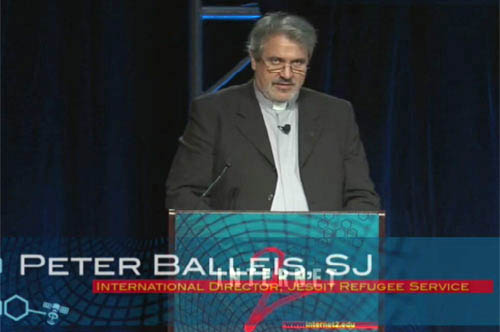
by Jesuit Refugee Service
With less than one university-trained teacher for every 280 Darfur refugees in Chad, the case for greater access to higher education is clear. To meet these needs, Jesuit Refugee Service plans to expand its provision of higher education from three to 10 sites by 2018.
Assessments are underway in Afghanistan, Burma and Chad, said JRS International Director Fr. Peter Balleis S.J. at an international technology meeting in Arlington, Virginia. Held by Internet2, the theme was Big Ideas. Big Collaboration. Big Impact. Eight hundred technology innovators heard Fr Balleis discuss the impact of technology on refugee education.
Georgetown University President John DeGioia, and World Bank Information Communication Technology Policy Specialist Samia Melhem also described how technology, volunteers and advanced networks are enabling organizations to deliver education to students in refugee camps, remote villages, war zones and other areas lacking a civil society.
“The objective of JRS is to empower those at the very edges of our societies — be it due to poverty, location, opportunity or circumstance — through access to higher education … so that they can contribute their knowledge and wisdom to our global community of learners,” said Fr. Balleis.
“Just imagine how much brain power and intelligence is lost to the world when a billion people or more are not integrated. We all lose. With technology, we together foster a hope of a more peaceful and humane world,” he said.
According to Fr. Balleis the future will be determined by knowledge, connectedness and access to information. It is the knowledge gap which fuels conflict in places like the Sahel and Afghanistan.
For instance, JRS is managing schools in seven camps in Chad for 60,000 refugee students. The challenge, said F.r Balleis, is to use technology to train all the teachers in the camps in the country.
“To do that, JRS needs access to the internet, computers and solar energy. But it also needs the expertise of universities like Georgetown… I’d like to add one word to today’s motto, big ‘needs.’ With ideas, there is a change of big collaboration and it will have a big impact.”
He reminded the audience that their technology inventions are part of something much bigger — global connectedness and learning.
In cooperation with Jesuit Commons: Higher Education at the Margins, JRS delivers higher education to refugees in Jordan, Kenya and Malawi, with university institutions seeking a practical way to take education where it is needed most. As part of this project, faculty and staff donate time, refugees and staff build their learning spaces, institutions volunteer courses, Microsoft engineers give time and software, and universities provide accreditation.
Internet2 is a technology community founded by leading higher education institutions in 1996, providing a collaborative environment for US research and education organizations. Together, they solve common technology challenges, and develop innovative solutions in support of educational, research, and community service missions.









